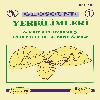Ahiler (Sivihisar-Eskişehir) sepiyolitinin jeokimyasal özellikleri
Sivrihisar göl baseninde alkalin ve tuzlu ortam koşullarında oluşmuş Neojen sepiyolit yatakları bulunmaktadır. Bölgedeki sepiyolitler başlıca üç tiptir, 1) Organik madde yönünden zengin siyah sepiyolitler, 2) Organik madde yönünden fakir kahverengi sepiyolitler, 3) % 20-40 oranlarında dolomit içeren dolomitli sepiyolitler. Sepiyolitlerin oluşum koşullarını açıklayabilmek için, sepiyolit örnekleri üzerinde x-ışınları yansıması (XRD), ana, iz, nadir toprak elementleri (REE) ve karbon izotop ($delta^{13}$C) analizleri yapılmıştır. Sepiyolitler ideal kristal yapıdadır ve etilen glikol ile duyurulduğunda az bir şişme (0.04$circ$ A) gösterir. Sepiyolitin oktaedral yapısındaki esas katyonlar sırasıyla Mg, Al, Fe ve Ti'dur. Kimyasal analizlere göre; Sr, Ba, Mo, Se, Li, As, Br ve Cl sepiyolitlerde en fazla bulunan eser elementlerdir. Aynı şekilde 3120 ppm ile 5716 ppm arasında değişen yüksek V değerleri çökelme sırasında indirgen koşulların varlığını belirtmektedir. Ayrıca, V içeriğinin alttan üste doğru azalması istifin üst kesimlerine doğru indirgen koşulların değiştiğini ve yükseltgen koşulların hakim olduğunu işaret eder. Sepiyolitlerde REE (La, Ce, Pr, Nd, Sm, Eu, Gd, Tb, Dy, Ho, Er, Im, Yb, Lu) miktarı ortalama 13.72 ppm olarak belirlenmiştir. Ahiler sepiyoliti REE değerleri, normalize edilmiş Kuzey Amerikan Şeyl Komposit (NASC) değerlerine göre Hafif Nadir Toprak Element (LREE) içerikleri yönünden bir fakirleşme gösterir. Sepiyolitler deki organik karbon miktarı % 0.38 ile 2.56 arasında değişmektedir. Tüm sepiyolit örneklerinde yüksek olan C/N oranı (ortalama 28.26) ileri derecede bir ayrışmayı gösterir. 5 $delta^{13}$C değerleri (ortalama - 26.22 % o) çok düşüktür. Buna göre, organik malzeme, C3 bölgesinde (fazla nemli ve soğuk koşullarda) yaşayan bitkilerden türemiştir.
Geochemical characteristics of Ahiler sepiolite (Sivrihisar-Eskişehir)
Sepiolite deposits were formed in Sivrihisar Neogene lacustine basin under alkaline and saline conditions. Three types of sepiolite have been determined in the Neogene basin; 1) Black sepiolite (rich in organic matter), 2) Brown sepiolite (poor in organic matter), 3) Dolomitic sepiolite (dolomite content is 20-40 %). X-ray diffraction (XRD), major, trace, rare earth element (REE) and carbon isotope ($delta^{13}$C) analyses were performed on the sepiolite samples to explain the conditions of the formation of sepiolites.Sepiolites were formed ideal crystal structure and expand slightly (0.04$circ$ A) when the sample is solvated with ethylene-glycol. Mg, AI, Fe and 77 are the main cations in octahedral sites of the sepiolite structure. Chemical analyses showed that Sr, Ba, Mo, Sc, Li, As, Br and CI are the most abundant trace elements in the sepiolites. It is also found that high V content ranging from 3120 ppm to 5716 ppm suggest the presence of anoxic conditions at the time of deposition. In addition, decreasing in vertical distribution in V content also indicates that anaerobic conditions change to aerobic conditions upward sequence. The amount of total REE's (La, Ce, Pr, Nd, Sm, Eu, Gd, Tb, Dy, Ho, Er, Tm, Yb, Lu) are the average of 13.72 ppm. In comparison with the NASC (North American Shale Composite) pattern, Ahiler sepiolite shows a depletion in Light Rare Earth Elements (LREE). The organic carbon content ranges from 0.38 to 2.56 wt %. The C/N ratio is high (average of 28.26) in all sepiolite samples suggesting highly advance stage of decomposition. $delta^{13}$C values are very low (average - 26.22 % o) in sepiolites, indicating organic material derived from distinct C3 pathway plants (living under cool and high moisture conditions).
